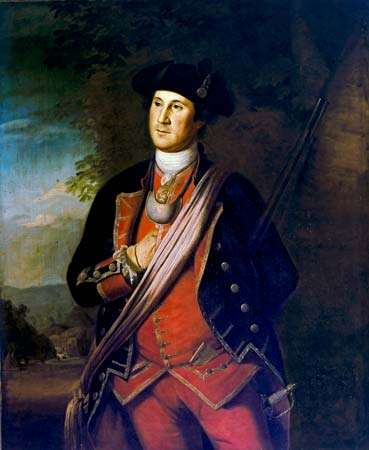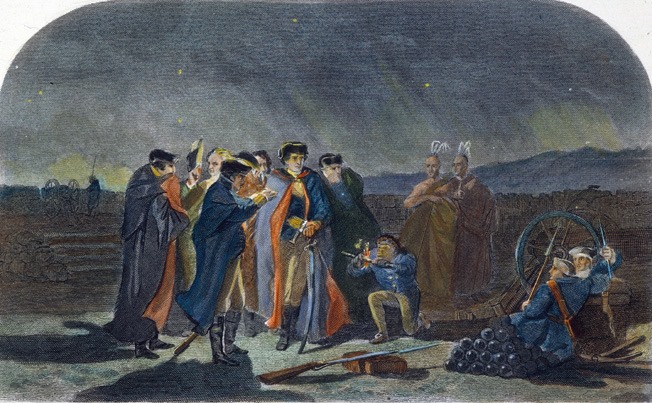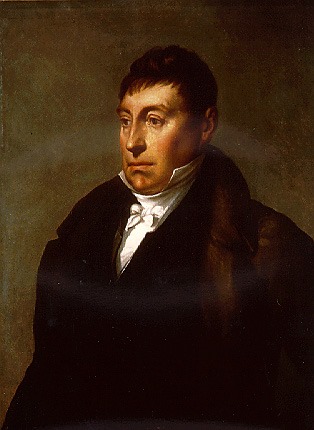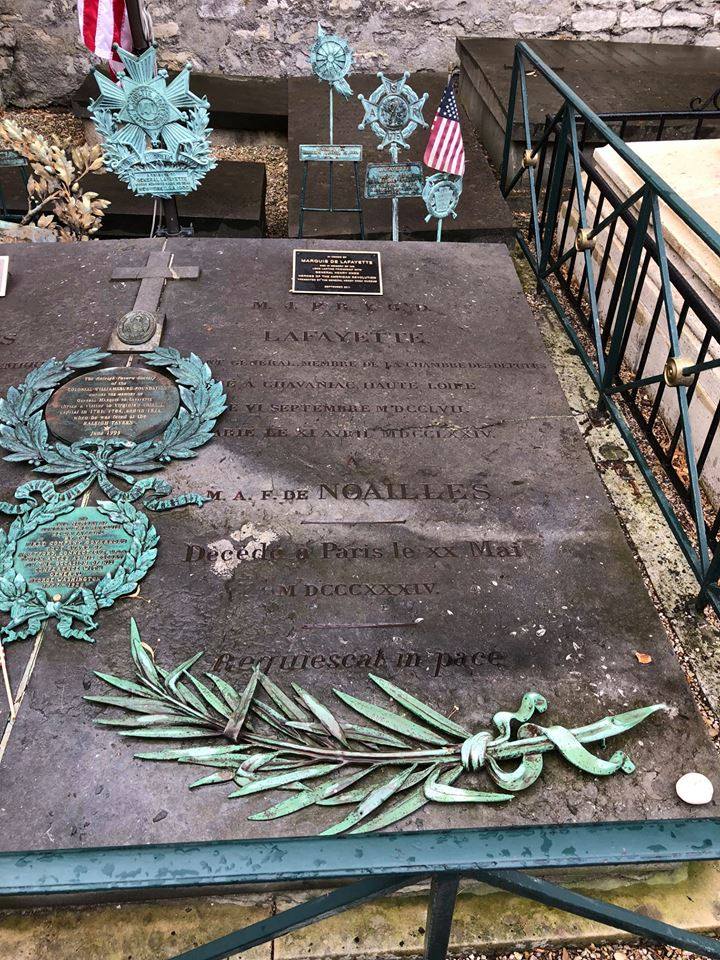Connections between the lives of the Marquis de Lafayette and Jean Baptiste Lapaise de Védrines
Today is the anniversary of the death of Marquis de Lafayette who died on this day in 1834. Below is a reflection I wrote about the connections between the lives of the Marquis de Lafayette and Jean Baptiste Lapaise de Védrines. It’s a little long, but may be of interest to those who enjoy history.
During the summer of 2018 – the 275th anniversary of Jean Baptiste Lapaise de Védrines’ departure from France and arrival in LA – I had the opportunity to visit once again the places associated with the origins of the Vidrine Family in France, including the Midi in the region of Auvergne (where the name originated), the city of Ste. Livrade in the region of Agen and the Chateau de Vedrines in the region of Bordeaux in the south west, as well as the city of Rochefort on the west coast of France where Jean Baptiste Lapaise de Védrines was recruited to join the French Marines and from where he departed France for LA.

But throughout that same year – 2018 – the Diocese of Lafayette (where I am a Priest) was celebrating its Centennial, so while in France, I took the opportunity to visit a few places associated with the Marquis de Lafayette. One was the ancestral chateau where he grew up and which he inherited – the Chateau Chavaniac-Lafayette, also in the region of Auvergne in France’s Midi where the Védrines Family originated. Then while in Rochefort, I was able to visit the full size replica of the Hermione – the ship that the Marquis de Lafayette paid to have built and which he boarded to set out from Rochefort in March 1780, bound for Boston. He was charged with giving George Washington the nation-saving news that France would soon be sending an infusion of arms, ships and men. Finally, while in Paris, I visited the Picpus Cemetery in Paris where the Marquis de Lafayette and his wife are buried.
While I knew that Jean Baptiste Lapaise de Védrines and the Marquis de Lafayette were both from France and that both traveled from France to North America, I didn’t think much of their possible connections or how their lives might have intersected until a few months after the 275th anniversary of the Vidrine Family in LA ended. Earlier this year (2019), I traveled once again to Washington DC with the Eighth grade class of my church’s school. While there, we visited Mount Vernon, the ancestral estate of George Washington. It wasn’t my first visit at Mount Vernon. During a visit there the previous year, I noticed the portrait of the Marquis de Lafayette in the room named the Lafayette Room. It’s the room in which he stayed during his visits to the estate of George Washington. On this visit to Mount Vernon, though, I picked up two books in the book shop that garnered my interest: My Dear General: The Extraordinary Relationship between George Washington and the Marquis de Lafayette by Jeffery E Finegan, Sr. as well as a biography, The Marquis: Lafayette Reconsidered by Laura Auricchio. While reading these two books, I was able to piece together some connections between Jean Baptiste Lapaise de Védrines and the Marquis de Lafayette and to see how their lives intersected each other in interesting ways.
In January 1743, Jean Baptiste Lapaise de Védrines was sent to the Louisiana Territory as an Officer of the French Marines to serve King Louis XV and the Kingdom of France in the New World, and especially to reinforce the French Marines in the face of British incursions into the territory claimed by France. After serving 8 years with Governor Vaudreuil in New Orleans (with whom he had arrived on the Charente in May 1743), Jean Baptiste Lapaise de Védrines was sent to serve in Upper LA in the Pays des Illinois at the Fort de Chartres in the summer of 1751. England and France were still relatively at peace, but his fellow French Marines were engaged in an interesting battle just a few years later. In May 1754, Joseph Coulon de Villiers de Jumonville led a small detachment of French to notify the British that they were trespassing on territory claimed by France in the Ohio Country, including the territory of the upper Ohio River in what is today western Pennsylvania.
George Washington, a young Colonel of the British Army commanding a detachment of Virginia militia, ambushed Jumonville’s party, killing him and several others. This event was one of the first battles of the French and Indian War (known in Europe as the Seven Years’ War). A few months later, Jumonville’s brother Louis Coulon de Villiers avenged his brother’s death, defeating Washington and forced his surrender at Fort Necessity…the only military surrender of his long career…and it happened on the 4th of July (1754)!
This is the description of that surrender:
“By 11:00am on the 3rd of July 1754, Louis Coulon de Villiers came within sight of Fort Necessity. Washington was occupying the Fort and began to prepare his garrison for an attack.
Coulon moved his troops into the woods, within easy musket range of the fort. Deciding to strike first, Washington ordered an assault with his entire force across the open field. Seeing the assault coming, Coulon ordered his soldiers, led by Indians, to charge directly at Washington’s line. However, the Virginians fled back to the fort, leaving Washington and the British greatly outnumbered. Washington ordered a retreat back to the fort.
Louis Coulon de Villiers sent an officer under a white flag to negotiate. Washington sent one of his officers along with a translator, to negotiate. As negotiations began, the Virginians, against Washington’s orders, broke into the fort’s liquor supply and got drunk. Coulon told the translator that all he wanted was that Washington surrender the garrison, and the Virginians could go back to Virginia. He warned, however, that if they did not surrender now, the Indians might storm the fort and scalp the entire garrison.
This message was brought to Washington, and he agreed to these basic terms. One of Louis Coulon de Villiers’ aides wrote the terms of surrender and then gave them to Washington’s translator, who translated them for Washington because he couldn’t read French. Washington signed the document of surrender. On July 4, Washington and his troops abandoned Fort Necessity. And he and his troops headed back to eastern Virginia” (see Edward Lengel, General George Washington. New York: Random House, 2005, pp. 40-44).
While the Surrender at Fort Necessity was a humiliating defeat for the young George Washington and the British Army, it plays an important part of the story of Washington’s life. In the course of it, the young Colonel displayed tremendous bravery and courage, which would be remembered by all when the plans for the American Revolution would begin.
Jean Baptiste Lapaise de Védrines himself was not personally engaged in the battle against George Washington and his militia in 1754, but it’s easy to imagine the joy Louis Coulon de Villiers and his men shared with their fellow French Marines when they arrived back at the Fort de Chartres, IL. Surely, at this point, Jean Baptiste Lapaise de Védrines never imagined that his sons would one day be living in a nation which would have George Washington as its first President! But now that it had begun, it was the Seven Years’ War that Jean Baptiste Lapaise de Védrines and his fellow Marines would be engaged in during the rest of his time at the Fort de Chartres until they lost it to the British in 1763.
After the French defeat at the hands of the British in 1763, Jean Baptiste Lapaise de Védrines retired from active service in the French Marines and descended the Mississippi River with his wife and family to resettle in lower LA. Arriving in New Orleans, they first settled at Pointe Coupee for almost 10 years. By the summer of 1773, they moved further west to the Opelousas Post (which would later be named after the general his French Marines had defeated: Washington, LA).

A few years later, the American Revolution would begin. The young 19-year-old Marquis de Lafayette had great interest in the fight for freedom beginning in the New World. He first learned of the American Revolution at a dinner on August 8, 1775 hosted by the Comte de Broglie for the Duke of Gloucester. The Duke spoke openly and favorably of the American revolutionaries, and Lafayette became intensely interested. During the winter of 1776, however, Lafayette’s interest in the American cause was not exclusive. Auricchio writes:
“In fact, it could hardly be called unusual. The fashionable salons of Paris were abuzz that season with talk of “les insurgents” as the envoys sent by Congress were called…If pleasure-loving Parisians enjoyed the novelty of these New World republicans, many military men saw the Americans’ cause as an opportunity for revenge. The army had been nursing its wounds since 1763, when the French and Indian War had ended with France ceding its Canadian colonies to Great Britain. By helping to wrest thirteen valuable colonies from British control, a humiliated French officers’ corps hoped to redeem itself” (The Marquis, Introduction, XXI).
Having retired from a life of service with the French Marines and settled at the property on which he would remain, Jean Baptiste Lapaise de Védrines was listed on the Opelousas Militia Roll on April 15, 1776. Of the 127 men listed, 34 were exempt from duty due to age or infirmity. [Jean Baptiste Lapaise] Pierre de Vidrine is listed among the exempt. (Muster Roll of the Opelousas Militia, April 15, 1776, AGI, PPC, legajo 161) During the early days of the Louisiana Colony, it was the duty of all able young men to serve in the Militia, and to do their part to insure the protection of all. There’s no doubt Jean Baptiste was thankful that he was too old to serve as many of his neighbors left to join the Spanish in the fight against the English, his old foe. While he had spent his life serving France’s efforts to defeat the British, he was now to old to prepare for the new battles.
But the young Marquis de Lafayette in France was just getting started. And ironically enough, it was the young Colonel defeated by Jean Baptiste Lapaise de Védrines’ French Marines who would now be leading the effort of the American colonies’ fight against the British.

The Marquis de Lafayette arrived in America in June 1777. Later that summer, he finally had the chance to meet General Washington, whom he had heard so much about. Auricchio writes:

“Lafayette remembered being awed when he first caught sight of “that great man”. Washington was standing across a crowded room at the City Tavern “surrounded by officers and citizens,” yet despite the throng, “the majesty of his figure and of his size made it impossible” to mistake his identity. In some ways, the forty-five-year-old Washington represented all that Lafayette hoped to become – a figure universally respected for his dignity, honor, and restraint. There were even physical similarities. Like the young Frenchman, Washington was considerably larger the average man of the era; standing six feet tall, he towered over even Lafayette. Yet, whereas Lafayette’s bulk made him something of an awkward presence in the refined salons of Paris and Versailles – a bull in a china shop, gingerly stepping around the delicate furnishings that represented the height of fashionable interior design France – Washington bore his height regally, his great size seeming like a mark of great character. Even before the two men were formally introduced, Washington had achieved the status of an idol to the fatherless Lafayette, who, brimming with hope, yearned for glory in a strange land…Initially, this admiration was not altogether mutual. The circumspect Washington hid his doubts from Lafayette, but he was not well disposed toward the French in general. Having fought against their troops in the French and Indian War, Washington spoke out against the French meddling during the du Caudray imbroglio. Writing from Morristown, New Jersey, on July 27, he complained mightily about the unwelcome influx of French officers who “embarrass me beyond measure” (The Marquis, p. 48).
General Washington gave the command to the Marquis de Lafayette Lafayette at the Battle of Brandywine in September 1777 in which he was wounded in the leg. He went to the Moravian hospital in Bethlehem, PA where he recuperated quickly. The young French soldier immediately became a patriot in the eyes of the American revolutionaries. He rejoined Washington in October 1777 and spent the winter with Washington’s army at Valley Forge, where the Americans gained greater confidence in the young general. By the start of the new year, Lafayette was again ready to battle. In January 1778, the Board of War gave Lafayette the position of leading an invasion of Canada, which he accepted with great enthusiasm. However, once they reached Albany, NY, he discovered that no preparations had been made and an attack would not be possible. He returned to Valley Forge in April. In June 1778, Lafayette was once again serving with the Americans at the Battle of Monmouth, New Jersey. By August, he was acting as liaison officer to the French Admiral d’Estaing in the joint French-American attack on Newport, Rhode Island, which was disastrous. With disappointment, Lafayette petitioned Congress for a leave from his service, which he received. He returned to France on January 11, 1779.
Choosing to join in the American Revolution, King Charles III of Spain officially declared war against Britain on May 8, 1779. Two months later on July 8, 1779, he invited Spanish subjects in North America to join. Bernardo de Gálvez, the Spanish Governor of Louisiana at that time, made immediate plans for a campaign to take the English colony of West Florida, which then extended all the way to the Mississippi River, for the King of Spain. By that fall, he was prepared and took the fight with his Louisiana soldiers to the British, forcing them to surrender. They agreed to surrender Natchez as well. Amazingly, throughout the series of events known as the Battle of Baton Rouge, only one person from Gálvez’s party died. A local justice of the peace joked that the British surrendered during the “mighty battle” because a British officer “wounded his head on his tea table.” (Chris Dier, Louisiana’s Fight in the Revolutionary War, https://yatlagniappe.com).
While the Battle of Baton Rouge may not be well known in the larger scope of the Revolutionary War, the assistance Louisiana gave to Spain was vital to the War. And that was only possible because Gálvez received the support of early Louisiana residents, which included Acadians at the Attakapas Post, free people of color, Isleños from St. Bernard Parish, German immigrants along the German Coast, and French Creoles at the Opelousas Post. While it was the first time they all came together for the common cause of fighting against a foreign enemy, it would not be the last time they did so.
Lafayette was not finished assisting America with its Revolutionary War and returned for its final phase. By March 1780, Lafayette set sail for America to prepare for French forces to arrive afterward with plans he had discussed with them while back in France. Once he reached the United States, Lafayette went to Morristown, NJ to meet with Washington about the plans to attack with the French army and fleet.
A few months later, in July 1780, he met with the Comte de Rochambeau, who arrived with a French army at Newport, RI. Shortly after, Lafayette served as an intermediary when Washington met Rochambeau. Then Lafayette returned with Washington to West Point, NY. Two battles
In early 1781, Washington gave Lafayette command of 1,200 New Englanders, with orders to defend VA against an attack by Benedict Arnold, now a British general commanding a British army, and to capture Arnold. While Arnold managed to escape, Lafayette went on to defend Richmond, the new capital of VA, against an attack by British General Phillips.
Then in May 1781, British General Lord Cornwallis and his army entered VA. Lafayette had been reinforced with General “Mad Anthony” Wayne’s PA troops, and the combined force withstood Cornwallis’s army, which eventually moved back east towards Portsmouth, VA and then to Yorktown. Generals Washington and Rochambeau had already begun marching their armies south to trap Lord Cornwallis, and Lafayette joined the main French-American force with them to siege Yorktown. This allied victory at Yorktown was the decisive battle of the Revolution, and Lafayette knew it immediately. Writing to the Comte de Maurepas after the battle, Lafayette stated emphatically: “the play is over, the fifth act is just ended.”
Auricchio writes: “In 1781, after the British surrendered to allied forces at Yorktown, most of the French officers in American returned to France and to the pursuits they had left behind. But Lafayette, who had left his homeland as an outcast, had no career to reprise. Serving as America’s foremost French advocate became his primary occupation, and the spirit of the new nation assumed a position at the very core of his being” (The Marquis, Introduction, XXIII).
By the end of that year, in December 1781, Lafayette departed America once again for France. Even more so at this return, he was received by all as a conquering hero. Inspired by the successful American Revolution, he had returned to France with a new vision. He wanted to bring to France something of the liberties he had experienced and fought for in America. He wanted to enshrine in France a Constitutional Monarchy with a charter of liberties, and helped to begin the French Revolution as one of the most popular figures in France. What he had helped to begin, however, quickly turned out very differently from what he had experienced in America’s Revolution or what he had envisioned for France. Once the radical Jacobins gained control of the French government, he became an outcast as they unleashed the infamous “Reign of Terror.” Lafayette fled France and was captured by the Austrians, where he was held in prison from 1792-1797. And despite the efforts of the U.S. Congress and President Washington for his release, it was only after the intervention of the recently victorious general Napoleon Bonaparte that finally obtained his freedom.
Jean Baptiste Lapaise de Védrines died peacefully and in God’s grace on January 15, 1788 at his homestead at the Opelousas Post, LA (now Washington, LA). Most of his family whom he left behind in France had passed away by the time of his death. Seven months later, his youngest brother (and last remaining sibiling), Fr. Guillaume de Védrines, OSB, died after a few months of sickness on August 7, 1788 as a senior Benedictine monk at the Abbey of Sainte-Croix in Bordeaux, France.
However, the nieces and nephews of Jean Baptiste Lapaise de Védrines, children of his older brother, Pierre de Védrines, were affected greatly by the Revolution that the Marquis de Lafayette had helped to begin.
From a civil record in November 1790, we know that Jean Baptiste de Védrines (son of Pierre and nephew of Jean Baptiste Lapaise de Védrines) was a Knight of Saint Louis and former Captain of the regiment of Piedmont. His father Pierre died in 1773, and he inherited from his father the houses in Sainte Livrade, the farm at Lapeze, and the Chateau at Barsac. By 1790, he had sold the houses in Sainte Livrade and the farm at Lapeze, no doubt because of the turmoil of the French Revolution. His mother, who was living with him at Barsac in 1790 had sold her property at Preignac, which she had inherited from her family. Jean Baptiste died at the Chateau Doisy-Védrines on July 12, 1813 at the age of 76. In January 1797, his sister, Marie had to appear before the municipal administration with three witnesses to prove the place of her residence. According to the civil document, she lived in the Chateau (her house in the Pinesse) since 1789. That was the year the Revolution started. A description of Marie Védrines was given on her passport bearing the date 1790. She was 58 years old, and described thus: “Height of 5 feet, brown hair and eyebrows, blue eyes, well made nose, round front, average mouth, short chin and round face.”
Like Marie, Catherine and Marie Anne (all three of them Nuns or Religious Sisters) also went to live with their brother Jean Baptiste at the Chateau Doisy-Védrines when the dissolution of vows and closing of the monasteries during the French Revolution began. They each died there: Catherine, in 1773, Marie, in 1803, and Marie Anne, on October 4, 1814.

Ten years later, in 1824, President James Monroe and the US Congress invited Lafayette to visit the 24-state Union. Now in his mid sixties, General Lafayette arrived at Staten Island, NY on August 15. He visited all the 24 states of the Union in 13 months (August 1824 – September 1825) where he was greeted with exceptional celebration.

Returning to France for the final time, Lafayette died ten years later on May 20, 1834, at the age of seventy-eight. He was buried at Picpus Cemetery in Paris (which also contains two mass graves of those who were guillotined during the Revolution’s Reign of Terror). Lafayette’s tomb is covered in dirt taken from the site of the Battle of Bunker Hill.
